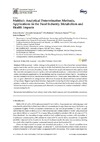Please use this identifier to cite or link to this item:
https://accedacris.ulpgc.es/jspui/handle/10553/73798
| Title: | Maltitol: Analytical determination methods, applications in the food industry, metabolism and health impacts | Authors: | Saraiva, Ariana Carrascosa Iruzubieta, Conrado Javier Raheem, Dele Ramos, Fernando Raposo, António |
UNESCO Clasification: | 3206 Ciencias de la nutrición | Keywords: | Food Additives Food Industry Food Safety Health Impacts Maltitol, et al |
Issue Date: | 2020 | Journal: | International Journal of Environmental Research and Public Health | Abstract: | Bulk sweetener maltitol belongs to the polyols family and there have been several dietary applications in the past few years, during which the food industry has used it in many food products: bakery and dairy products, chocolate, sweets. This review paper addresses and discusses in detail the most relevant aspects concerning the analytical methods employed to determine maltitol’s food safety and industry applications, its metabolism and its impacts on human health. According to our main research outcome, we can assume that maltitol at lower doses poses little risk to humans and is a good alternative to using sucrose. However, it causes diarrhoea and foetus complications at high doses. Regarding its determination, high-performance liquid chromatography proved the primary method in various food matrices. The future role of maltitol in the food industry is likely to become more relevant as processors seek alternative sweeteners in product formulation without compromising health. | URI: | https://accedacris.ulpgc.es/handle/10553/73798 | ISSN: | 1661-7827 | DOI: | 10.3390/ijerph17145227 | Source: | International Journal of Environmental Research and Public Health [ISSN 1661-7827], v. 17 (14), 5227, (Julio 2020) |
| Appears in Collections: | Reseña |
SCOPUSTM
Citations
57
checked on Jun 8, 2025
WEB OF SCIENCETM
Citations
41
checked on Jun 8, 2025
Page view(s)
152
checked on Nov 23, 2024
Download(s)
153
checked on Nov 23, 2024
Google ScholarTM
Check
Altmetric
Share
Export metadata
Items in accedaCRIS are protected by copyright, with all rights reserved, unless otherwise indicated.
